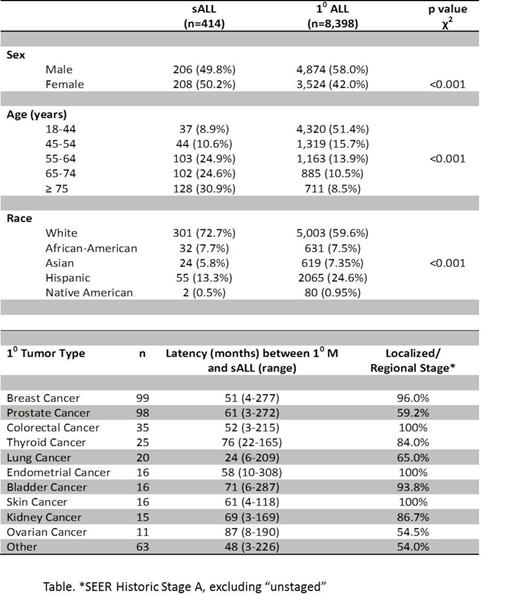Abstract
Background: The incidence of secondary Acute Lymphoblastic leukemia (sALL) after a preceding first primary solid organ malignancy (1M) is not well defined. We undertook a Surveillance Epidemiology and End Results (SEER)-based analysis to describe the occurrence of sALL among adult patients with a history of common 1M's. We also evaluated differences in sALL survival on the basis of age, the site and extent of 1M, and for evidence of any underlying racial/ethnic disparity.
Methods: The SEER-18 database (1973-2011) was interrogated for the current study. All confirmed cases of ALL (ICD-O-3 codes: 9811, 9812, 9814-18, 9826-28, 9835-37) in adult patients (age ≥18 years) were identified. De novo ALL vs. sALL was determined by using the SEER variable First Malignant Primary Indicator'. 1M prior to the diagnosis of ALL was identified by merging all SEER databases together by patient ID number. Those with 1M stage of in situ'; sALL cases reported <2 months after the diagnosis of 1M; and those with unknown information on 1M (n=471) were excluded. Standard race/ethnicity categories were used. Latency interval (time from diagnosis of 1M to sALL) was calculated for all patients. Overall survival (OS) was calculated as the interval from diagnosis to death, or censored at date of last contact, December 31st 2011, or 5 years after diagnosis, whichever came first. A proportional hazards Cox regression model was performed to evaluate the impact of sALL and latency on OS, adjusting for age at diagnosis, race/ethnicity, marital status, birthplace, SEER registry site, and year of diagnosis. All statistical tests were two-sided and utilized the SAS software (v9.4) with a two-sided significance level of 0.05.
Results: A total of n=8,398 adult patients with primary ALL (1ALL) and n=414 with sALL were identified. Patient characteristics were significantly different between 1ALL & sALL (Table). Males comprised 49.8% of sALL patients as compared to 58% with 1ALL. Age at diagnosis of ALL was also significantly different, with 55.5% of sALL patients being ≥65 years as compared to 51.4% of 1ALL observed in the 18-44 years age group. Non-Whites comprised 27.3% of sALL and 40.4% of 1ALL, with Hispanics having the most differential distribution of 13.3% and 24.6%, respectively in the two groups. Distribution of sALL patients by latency from 1M is shown in Table. The majority of sALL patients had a diagnosis of local/regional (rather than advanced stage) 1M (Table). sALL patients had a significantly inferior OS when compared to 1ALL (HR 1.211, 95%CI 1.079-1.359) (Median OS 14 months vs. 18 months, Figure). sALL cases with longer latency interval (>5 year) appeared to have better median OS compared to shorter latency intervals, but this difference was not statistically significant (p=0.53).
Conclusion: We have performed the largest population-based analysis identifying sALL after 1M, demonstrating that sALL patients are older and have significantly worse OS than 1ALL. We noted a lower relative incidence of sALL in Hispanics as compared with 1ALL, while the converse was true for Whites. Although detailed treatment data (specifically with respect to chemotherapeutic agents) is not available in SEER, it is possible that treatment for local/regional 1M - presumably adjuvant in nature - may be associated with the risk of sALL. Further analyses are required and are ongoing to confirm the relative incidence after specific 1M's, and the impact of both specific treatment modalities and the era of treatment for 1M on risk of developing sALL.
No relevant conflicts of interest to declare.
Author notes
Asterisk with author names denotes non-ASH members.



This feature is available to Subscribers Only
Sign In or Create an Account Close Modal